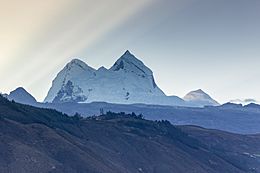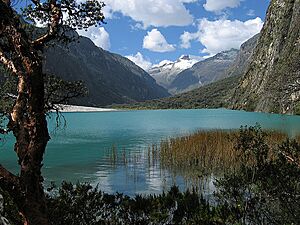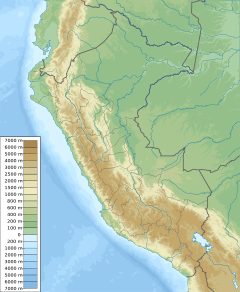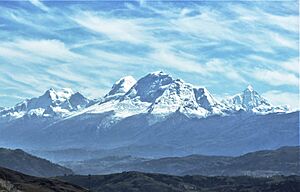Cordillera Blanca facts for kids
Quick facts for kids Cordillera Blanca |
|
|---|---|

Huandoy (6,360 m)
|
|
| Highest point | |
| Peak | Huascarán |
| Elevation | 6,768 m (22,205 ft) |
| Dimensions | |
| Length | 180 km (110 mi) N-S |
| Width | 21 km (13 mi) |
| Geography | |
| Country | Peru |
| State/Province | Ancash |
| Range coordinates | 9°10′S 77°35′W / 9.167°S 77.583°W |
| Parent range | Andes |
The Cordillera Blanca (which means "white mountain range" in Spanish) is a huge group of mountains in Peru. It's part of the larger Andes mountain range. This range stretches for about 200 kilometers (124 miles) from north to south.
It has many tall peaks, with some rising over 6,000 meters (19,685 feet) high. There are also 722 individual glaciers here. The highest mountain in Peru, called Huascarán, is found in the Cordillera Blanca. It stands at 6,768 meters (22,205 feet) tall.
The Cordillera Blanca is located in the Ancash Region of Peru. It runs right next to the Santa River valley. Most of this mountain range is protected as part of Huascarán National Park, which was created in 1975.
The melting snow and ice from the Cordillera Blanca provide water for northern Peru all year round. Also, about 5% of Peru's electricity comes from a power plant in the Santa River valley. Sadly, the amount of ice covering these mountains has shrunk by about one-third since the 1970s.
Contents
What is the Cordillera Blanca?
The Cordillera Blanca is the largest group of ice-covered mountains in the world that are found in a tropical area. It holds the most ice in all of Peru. This range is part of the western Andes mountains in Peru. It stretches for 200 kilometers (124 miles) in a northwest direction.
It has five of the most amazing peaks over 6,000 meters (19,685 feet) in the Peruvian Andes. The tallest peak, Huascarán, reaches 6,768 meters (22,205 feet) above sea level. The Cordillera Blanca also acts like a giant wall that divides water. The Santa River on the west side flows into the Pacific Ocean. The Marañón River on the east side flows into the Atlantic Ocean.
Glaciers: The Shrinking Ice

In the 1990s, experts counted 722 separate glaciers in the Cordillera Blanca. These glaciers covered a huge area of 723.4 square kilometers (279.3 square miles). Most of them were on the western side of the mountains.
Most of these glaciers, about 91%, are "mountain glaciers." This means they are usually short and very steep. The others are "valley glaciers," which are longer.
Like other glaciers in the Andes, the Cordillera Blanca's glaciers have been melting a lot during the 20th century. This is due to global warming. Studies show that the glaciers have shrunk by more than 15% since the 1970s. By 2003, there were only 485 glaciers left, covering a smaller area of 569.6 square kilometers (219.9 square miles).
Lakes: Beautiful Blue Waters
The Cordillera Blanca is home to many beautiful lakes. Some of the most important ones are the Llanganuco Lakes. These lakes are on the northern side of Huascarán mountain. You can reach them from the town of Yungay.
Another important lake is the deep-turquoise Lake Parón. It's the biggest lake in the Cordillera Blanca. You can find it just north of Huandoy mountain and get there from the town of Caraz.
Other notable lakes include Lake 69, Lake Allicocha, Lake Auquiscocha, Lake Palcacocha, Lake Querococha, and Lake Conococha. Some lakes, like Ichiccocha and Jatuncocha, are only reachable by hiking or on horseback.
Peaks: Giants of the Andes
The Cordillera Blanca has many peaks that are over 6,000 meters (19,685 feet) tall. The highest peak is Huascarán Sur. Its height is usually given as 6,768 meters (22,205 feet).
Here are some of the highest peaks in the Cordillera Blanca:

- Huascarán, 6,768 m (22,205 ft)
- Huantsán, 6,369 m (20,896 ft)
- Huandoy, 6,360 m (20,866 ft)
- Chopicalqui, 6,354 m (20,846 ft)
- Chinchey, 6,309 m (20,699 ft)
- Palcaraju, 6,274 m (20,584 ft)
- Santa Cruz, 6,259 m (20,535 ft)
- Copa, 6,188 m (20,302 ft)
- Ranrapalca, 6,162 m (20,217 ft)
- Pucaranra, 6,147 m (20,167 ft)
- Hualcán, 6,122 m (20,085 ft)
- Chacraraju, 6,108 m (20,039 ft)
- Pucajirca, 6,046 m (19,836 ft)
- Quitaraju, 6,040 m (19,816 ft)
- Tocllaraju, 6,034 m (19,797 ft)
- Artesonraju, 6,025 m (19,767 ft)
- Caraz, 6,025 m (19,767 ft)
- Alpamayo, 5,947 m (19,511 ft)
- Taulliraju, 5,830 m (19,127 ft)
- Pisco, 5,752 m (18,871 ft)
- Yanapaccha, 5,460 m (17,913 ft)
- Urus, 5,423 m (17,792 ft)
Hot Springs: Nature's Warm Baths
The area also has important hot springs. These include Monterrey and Chancos. Both have been turned into places where people can enjoy warm thermal baths. They are located 7 and 27 kilometers (4 and 17 miles) from Huaraz, the main city in the region.
| Weather chart for Musho | |||||||||||||||||||||||||||||||||||||||||||||||
|---|---|---|---|---|---|---|---|---|---|---|---|---|---|---|---|---|---|---|---|---|---|---|---|---|---|---|---|---|---|---|---|---|---|---|---|---|---|---|---|---|---|---|---|---|---|---|---|
| J | F | M | A | M | J | J | A | S | O | N | D | ||||||||||||||||||||||||||||||||||||
|
86
20
7
|
86
20
8
|
105
20
7
|
59
21
7
|
19
21
6
|
3
22
4
|
2
22
3
|
9
23
3
|
21
23
5
|
54
22
6
|
51
22
6
|
62
21
7
|
||||||||||||||||||||||||||||||||||||
| temperatures in °C precipitation totals in mm source: Climate-Data.org |
|||||||||||||||||||||||||||||||||||||||||||||||
|
Imperial conversion
|
|||||||||||||||||||||||||||||||||||||||||||||||
Climate: Seasons in the Mountains
The Cordillera Blanca has a dry season that lasts from May through September. June and July are the driest months and have the most stable weather. This is a great time for visitors. The information in the chart shows the weather for the village of Musho, which is at the base of Huascarán mountain.
Ecology: Plants and Animals
The plants and animals in the Cordillera Blanca have learned to live in the mountain climate. Almost all of the Cordillera Blanca is protected inside Huascarán National Park. This park helps keep the unique nature safe.
Flora: Mountain Plants
The main types of plants in this area are found in two zones. The lower valleys have plants that can handle dry conditions. Higher up, you'll find shrubs and grasslands. Even higher, there are "Puna grasslands" and small areas of high Andean forests.
Plants in the mountains have special ways to deal with strong sunlight, cold temperatures, and limited water. Many plant species have fuzzy leaves. This fuzz helps protect them from losing water due to the strong sun and the cold nights.
Some common plants you might see include Polylepis racemosa (a tree with papery bark), Escallonia resinosa, Alnus acuminata, different kinds of Lupinus, and the giant Puya raimondii.
Fauna: Mountain Animals
More than 120 different kinds of birds have been seen in Huascarán National Park. Some of the most interesting birds include the huge Andean condor, the fast torrent duck, and the colorful Andean crested duck. You might also spot the Andean gull or the giant coot.
Many mammals also live in this area. These include the wild colocolo and the rare Andean mountain cat. You might also see the spectacled bear, the taruca deer, and the graceful vicuña. Other animals here are the white-tailed deer, the powerful puma, and the clever Andean fox.
See also
 In Spanish: Cordillera Blanca para niños
In Spanish: Cordillera Blanca para niños
- Cordillera Blanca Fault Zone
- List of mountains in Peru
- Huascarán National Park
- Ancash Region






